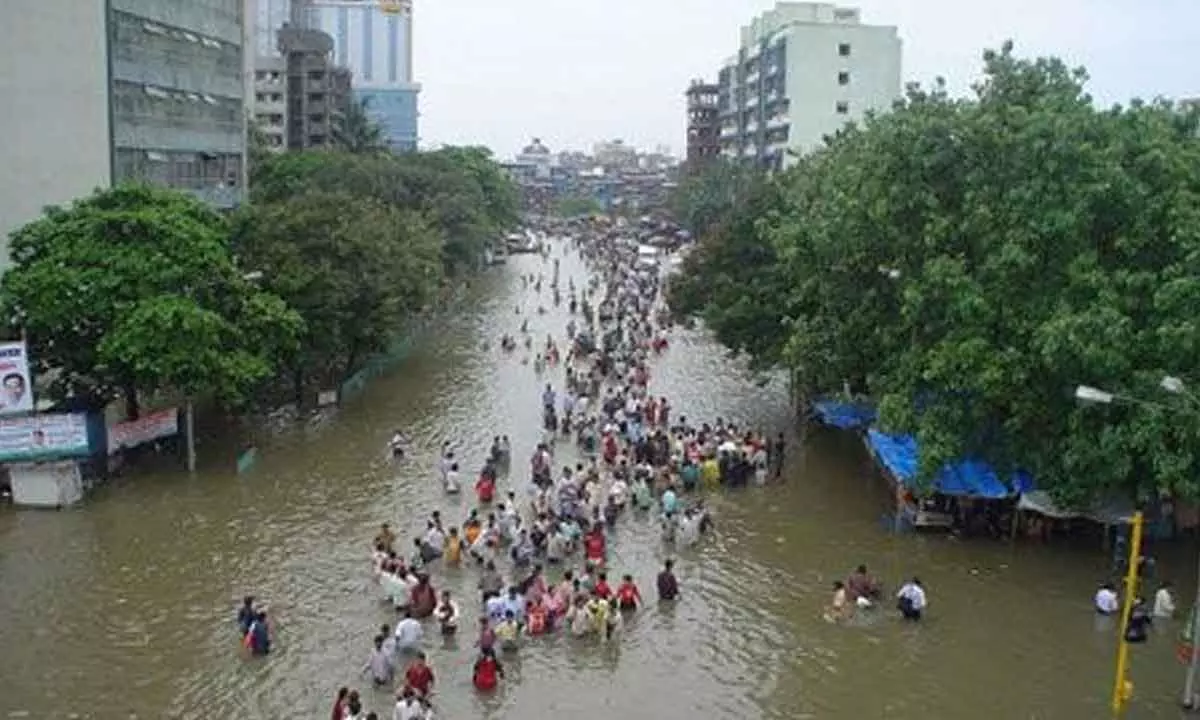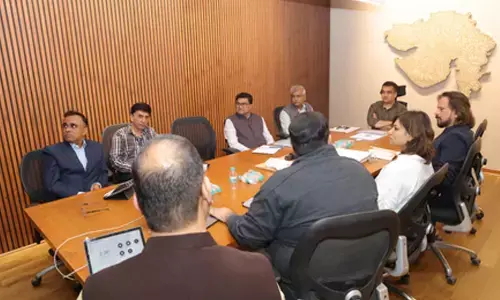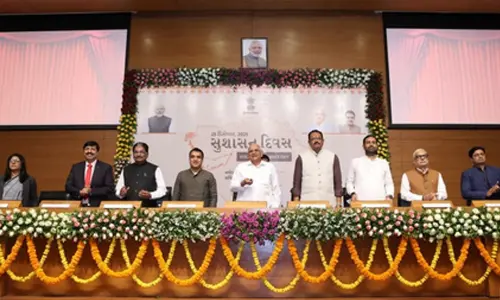This monsoon: Anything but normal

Climate change fingerprints all over monsoon this year: Experts
There has been a 52 per cent increase in the number of cyclones in the Arabian Sea, while very severe cyclones have increased by 150 per cent. The peculiarity of this year’s monsoon is evident in the fact that it covered both Delhi and Mumbai simultaneously for the first time since June 21, 1961, on June 25. In June, 377 stations across the country reported very heavy rain events (115.6 mm to 204.5 mm), the highest in the last five years, according to the India Meteorological Department data
Barring the cumulative rainfall over the country, this year’s monsoon has been anything but normal and experts point to climate change as the underlying cause.
From a cyclone with the longest lifespan in the Arabian Sea to devastating floods in parts of northwest India and the adjoining Himalayan states, as well as a prolonged break in the monsoon, the unmistakable imprints of climate change are evident this year, asserted Mahesh Palawat, a vice-president (Climate Change and Meteorology) at private forecasting agency Skymet Weather.
In early June, cyclone Biparjoy delayed the onset of the monsoon over Kerala and the advance over southern India and the adjoining western and central parts of the country. Meteorologists say the cyclone experienced rapid intensification initially and maintained its strength due to an unusually warm Arabian Sea. They emphasise that cyclonic storms in the Bay of Bengal and the Arabian Sea are intensifying rapidly and retaining their potency for longer periods due to climate change.
According to a study ‘Changing status of tropical cyclones over the north Indian Ocean’, the frequency, duration, and intensity of cyclones in the Arabian Sea have increased by about 20 per cent in the post-monsoon period and 40 per cent in the pre-monsoon period. There has been a 52 per cent increase in the number of cyclones in the Arabian Sea, while very severe cyclones have increased by 150 per cent. The peculiarity of this year’s monsoon is evident in the fact that it covered both Delhi and Mumbai simultaneously for the first time since June 21, 1961, on June 25. In June, 377 stations across the country reported very heavy rain events (115.6 mm to 204.5 mm), the highest in the last five years, according to the India Meteorological Department data.
July saw a considerable rise in the number of heavy rain events, with 1,113 stations reporting very heavy rainfall and 205 stations experiencing extremely heavy rainfall (above 204.5 mm), both being the highest in the last five years. “The message is clear: the monsoon is becoming more variable. Increased variability means more extreme weather and dry spells. What we’re witnessing now aligns with the studies on the impact of climate change on the Indian monsoon,” Madhavan Rajeevan, former secretary at the Ministry of Earth Sciences, said.
In July, unprecedented floods wreaked havoc in northwest India, particularly Himachal Pradesh and Uttarakhand, causing over 100 deaths. Mumbai had its wettest July, while the Yamuna in Delhi reached a record 208.66 metres. Over 80 people died after a landslide struck Irshalwadi of Raigarh district in Mahashtara on July 19 following heavy rainfall. August continued the trend, with heavy rainfall causing extensive damage in the fragile Himalayas of Himachal Pradesh and Uttarakhand, resulting in over 80 casualties.
However, the impact of climate change was more visible, higher than ever before, say climate experts. Th ey say it would not be wrong to say that extreme weather conditions have governed the southwest monsoon season so far. Record breaking extreme weather events ranged from humid heat waves to torrential rainy spells to cyclogenesis.
At the end of July, the cumulative countrywide rainfall was surplus by five per cent, with 467 mm of rain against the normal of 445.8 mm between June 1 and July 31. Heatwaves during the monsoon season are quite rare in India. With delayed monsoon arrival in eastern parts of the country, an unusual spell of heatwave wreaked havoc across the region. According to Climate Central, an independent group of scientists, a three-day extreme heat event over Uttar Pradesh from June 14-16 was made at least two times more likely by human-caused climate change. In Ballia in Uttar Pradesh temperatures reached 42.2 degrees Celsius on June 16 and at least 34 fatalities occurred over the three-day event. A similar situation was witnessed in the neighbouring state of Bihar, where school and colleges were closed to minimise the impact of the heatwave.
Professor Y P Sundriyal from HNB Garhwal University said that the Himalayas are increasingly vulnerable due to global warming. The hilly states are at risk due to their fragile ecology and limited capacity to handle incessant rains. Although monsoonal rains could lead to further damage in the Himalayan region, August may end up being one of the driest for India in recent times due to the long break in the monsoon phase, lasting from August 7 to August 18. This break is one of the longest in a century.
The northward migration of the monsoon trough – an elongated low-pressure area extending from heat low over Pakistan to the Bay of Bengal – leads to break monsoon conditions or suppression of monsoon rain over major parts of India, especially in the core monsoon zone or the rain-fed agricultural region spanning from Gujarat in the west to West Bengal and Odisha in the east. The northward movement of the monsoon trough or break-monsoon phase results in heavy rains along the foothills of Himalayas and parts of eastern India.
India has been witnessing normal to surplus monsoon rains for the last five years. This year too, the country is likely to record normal rains but with El Nino building in the Pacific Ocean chances of below normal monsoon cannot be ignored. However irrespective of monsoon performance, experts are expecting extreme weather events to increase in the coming years. “Characteristics of the monsoon have undergone some major changes, which have altered rainfall patterns, intensity, and frequency. These changes are constantly evolving with the increasing global temperatures,” remarked Mahesh Palawat, Vice President, Meteorology and Climate Change, Skymet Weather.
“As a result, extreme weather events have also increased exponentially. What happened in Himachal Pradesh and other parts of northwest India is evidence of how climate change is impacting and altering the monsoon season in India. “In fact, these impacts would continue to multiply if temperatures continue to rise.” Sounding the alarm that India is on track to breach a critical warming threshold, Indian Institute of Technology-Gandhinagar says climate change will increase the frequency of extreme weather events such as floods and heatwaves in the future.
The total population and urban area exposed to sequential extremes will increase rapidly if the global mean temperature rises above 1.5 degrees from the pre-industrial level. A considerable improvement in socioeconomic livelihood and infrastructure will be needed to reduce vulnerability and maintain the same level of risk at 1.5 degrees at higher global warming levels. The risks and drivers of the sequential extremes in India remain unrecognised.
“Monsoon breaks and normal rains are part natural variability of the monsoon. However, El Nino causes these break monsoon phases to continue for a longer period. This is what we are seeing this year. The stronger the El Nino, the longer the break phase,” Rajeevan said. There is natural variability associated with the monsoon. Rainfall (or the lack of it) is not solely the product of temperature. However, one cannot reject the idea that climate change is making the annual rain-bearing system more volatile, said D S Pai, a senior scientist at the India Meteorological Department (IMD). “Climate change is increasing the intensity and frequency of El Nino which in turn can trigger extreme rainfall events and longer break monsoon phase,” he added.
Extreme weather, climate and water-related events caused 573 disasters in India between 1970 and 2021 that claimed 1,38,377 lives, according to data from the World Meteorological Department. India recorded 2,227 human casualties due to extreme weather events in 2022, according to the Annual Statement on Climate of India, issued by the India Meteorological Department.
Scientists say climate change has made monsoons more erratic and volatile, leading to frequent landslides and flash floods in India’s Himalayan north. The Himalayas act as a barrier, which confronts the moist winds coming from the Arabian Sea as well as the Bay of Bengal.
With increasing temperatures, both at the surface and at the sea level, there has been a considerable increase in moisture content, which makes it a prone zone for torrential rains. We must remember, the Himalayan mountains have a fragile ecology, which has limited capacity to bear such incessant rains. This has put the hilly states, especially Himachal and Uttarakhand in a danger zone.
















